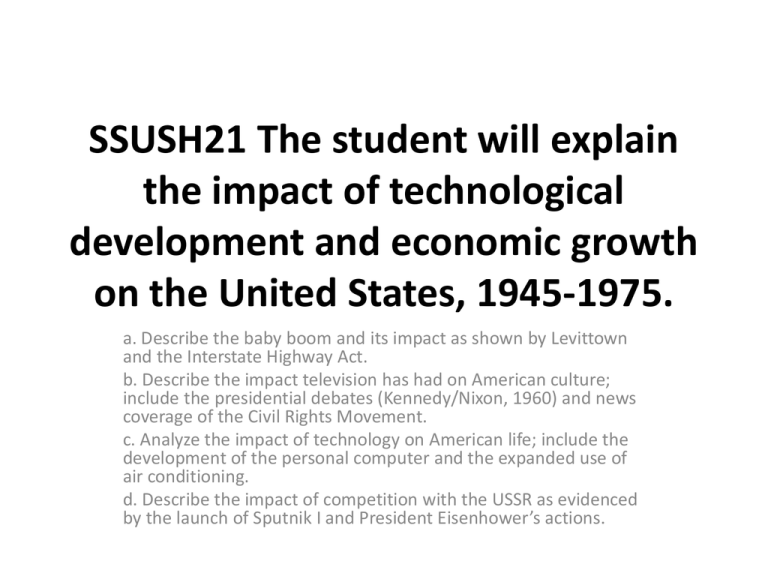SSUSH21 The student will explain the impact of technological
advertisement

SSUSH21 The student will explain the impact of technological development and economic growth on the United States, 1945-1975. a. Describe the baby boom and its impact as shown by Levittown and the Interstate Highway Act. b. Describe the impact television has had on American culture; include the presidential debates (Kennedy/Nixon, 1960) and news coverage of the Civil Rights Movement. c. Analyze the impact of technology on American life; include the development of the personal computer and the expanded use of air conditioning. d. Describe the impact of competition with the USSR as evidenced by the launch of Sputnik I and President Eisenhower’s actions. a. Describe the baby boom and its impact as shown by Levittown and the Interstate Highway Act. • Following the end of WWII and the return of millions of American servicemen, the birthrate in the US rose dramatically. The general economic prosperity of the late 40s and 1950s helped to sustain relatively high birthrates and the generation born during this “Baby Boom” period (1946-1964) became known as the “boomers”. • One consequence of the baby boom in the late 1940s was a critical, nationwide housing shortage. Part of the answer for the housing needs of young families across the nation was the large-scale development of affordable single-family “tract” homes in the suburbs. • One of the first planned suburban developments in the nation was on Long Island (near New York City), known as Levittown. The Levittown model, modest 2 or 3 bedroom homes on ¼ or ½ acre lots became the standard, and suburban developments sprang up on the outskirts of cities and towns across the country. a. Describe the baby boom and its impact as shown by Levittown and the Interstate Highway Act. • Another factor contributing to the mass migration toward the suburbs was the development of the Interstate Highway system. • The interstate system is a nationwide network of divided, controlled access highways that was the largest and most expensive public works project in US history. Passed in 1956, it was originally conceived as a necessity for defense and commercial transportation, but it had other consequences as well. • Interstates allowed people to live increasingly far from their jobs in the urban cores, commuting to and from work on the high speed roadways. b. Describe the impact television has had on American culture; include the presidential debates (Kennedy/Nixon, 1960) and news coverage of the Civil Rights Movement. • • • • Another revolutionary development of the Baby Boom era was the near universal adoption of television. TV sales and programming boomed through the 1950s, and by 1960, 90% of American homes had access to TV. As TV became the number one source of news and information for many Americans, it had a profound affect on politics as well. The rising influence of television on politics was illustrated by the 1960 presidential debates, which featured John F. Kennedy and Richard Nixon. As the story goes, many Americans who watched the debates on TV thought that Kennedy was the stronger candidate, while those listening on radio preferred Nixon. Kennedy looked tan and composed under the TV studio lights, while Nixon looked sweaty and clammy. The election was one of the closest in US history and many historians credit Kennedy’s photogenic and TV appeal as one of the factors that helped him win. Another major impact of TV is its connection to the Civil Rights movement. In the late 1950s and early 1960s, television reports and images of the brutal repression of Civil Rights helped to create a more sympathetic understanding of what African Americans were facing in their struggle for equality. Seeing on a daily basis the arrests, beatings, police dogs and fire-hose attacks on civil rights activists helped to change the minds of many Americans who might have been indifferent prior to seeing these images on TV. c. Analyze the impact of technology on American life; include the development of the personal computer and the expanded use of air conditioning. • • • The post-WWII era saw significant technological developments toward a feasible personal computer. The earliest computers were prohibitively large and expensive “mainframe” units that could take up entire rooms and were still very far from being practical in any way for personal use. The development of silicon transistors, integrated circuits and microprocessors in the 1960s and early 1970s went a long way toward personal computing. The digital calculator was the first computer that most Americans became familiar with, although through the 1970s and early 1980s, several models of home computers were being developed and sold. As technologies made personal computing more practical their use expanded through the 1980s and the stage was set in the 1990s for an explosion of personal computing at the dawn of the “information age”. Another technology that had an important impact in the decades after WWII was air conditioning. One of the most obvious effects was that areas in the southern half of the US (the so-called “Sun Belt”) became much more attractive places to live. As a result, the Sun Belt has seen significant population increases relative to other parts of the country. This population shift was additionally aided by the decline of manufacturing in the northern “Rust Belt” regions, and by the much improved civil rights in the deep south, both of which contributed to the mass of migrants leaving the north for the sunnier climes of the southern tier. d. Describe the impact of competition with the USSR as evidenced by the launch of Sputnik I and President Eisenhower’s actions. • An important component of the Cold War era was the technological competition that accompanied the broader ideological contest between capitalism and communism. Technological achievements were touted by both sides in the Cold War as evidence of the superiority of their socio-economic systems. An especially important aspect of this competition manifested in the “space race.” • In the late 1950s and early 1960s, the Soviets appeared to be winning the technological competition associated with the space race. Their first major achievement was in 1957, with the successful deployment of the world’s first satellite, called Sputnik. • Sputnik sent shock waves through the US and inspired Eisenhower to call for a new national emphasis on science and technology education. In the meantime, Eisenhower also greatly increased government funding for space related research and development, creating the National Aeronautics and Space Administration (NASA) in 1958.






